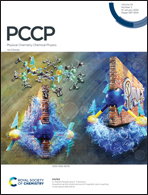The effect of interlayer stacking arrangements in two dimensional NiOOH on water oxidation catalysis†
Abstract
Electrolysis of water to produce green and renewable hydrogen fuel is of great interest in the clean energy field. Water molecules can be decomposed to hydrogen and oxygen through catalysis. Catalytic materials under electrochemical operation are subject to harsh chemical environments, and as a result mechanical changes may appear in the material. In two dimensional materials, the weak van der Waals (vdW) forces holding the layers together may cause a change in the stacking order of the material. The big challenge is to understand the effect of the interlayer arrangements of two dimensional materials on their catalytic performance. In this research we use Density Functional Theory in order to explore the catalytic performance of β-NiOOH, a two dimensional material that is one of the best known catalysts for the oxygen evolution reaction (OER), under different displacements. Our results indicate that changes in the structural stacking of NiOOH could affect the catalytic properties of the system. Particularly, we find that small shifts between the layers enhance the OER activity by reducing the overpotential down to 240 [mV] due to the formation of an unstable state and the formation of new vdW bonds between the layers. The potential ability to lower the overpotential of NiOOH could give exceptional results in increasing the efficiency of the OER.



 Please wait while we load your content...
Please wait while we load your content...